-
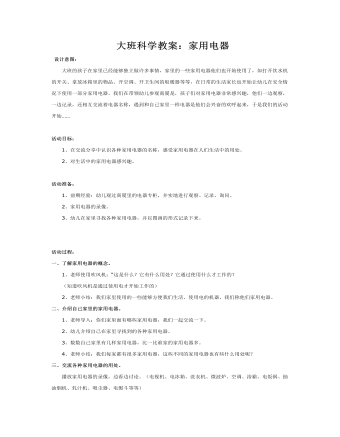
大班科学教案:家用电器
活动目标:1、在交流分享中认识各种家用电器的名称,感受家用电器在人们生活中的用处。2、对生活中的家用电器感兴趣。 活动准备:1、前期经验:幼儿观过商厦里的电器专柜,并实地进行观察、记录、询问。2、家用电器的录像。3、幼儿在家里寻找各种家用电器,并以图画的形式记录下来。 活动过程:一、了解家用电器的概念。1、老师使用吹风机:“这是什么?它有什么用处?它通过使用什么才工作的? (知道吹风机是通过使用电才开始工作的)2、老师小结:我们家里使用的一些能够方便我们生活、使用电的机器,我们称他们家用电器。二、介绍自己家里的家用电器。1、老师导入:你们家里面有哪些家用电器,我们一起交流一下。2、幼儿介绍自己在家里寻找到的各种家用电器。3、数数自己家里有几样家用电器,比一比谁家的家用电器多。4、老师小结:我们每家都有很多家用电器,这些不同的家用电器也有些什么用处呢?三、交流各种家用电器的用处。 播放家用电器的录像,边看边讨论。(电视机、电冰箱、洗衣机、微波炉、空调、浴霸、电饭锅、抽油烟机、轧汁机、吸尘器、电熨斗等等)1、这是什么?有什么用处?2、它们的形状、颜色一样吗?为什么要不一样?(满足人们不同的喜好)3、随机提问:你同意他的说法吗?还有什么意见?4、你们还有什么问题吗?可以提出来大家一起讨论?5、老师小结:家用电器用处可真大,它们给我们生活带来了方便。
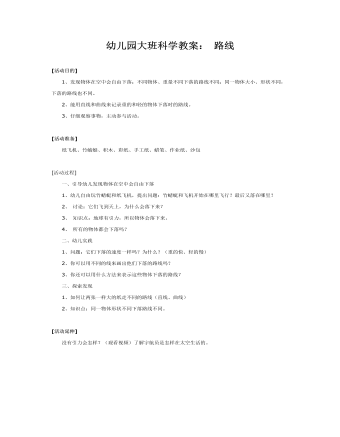
幼儿园大班科学教案: 路线
[活动准备] 纸飞机、竹蜻蜓、积木、彩纸、手工纸、蜡笔、作业纸、沙包 [活动过程] 一、引导幼儿发现物体在空中会自由下落1、幼儿自由玩竹蜻蜓和纸飞机,提出问题:竹蜻蜓和飞机开始在哪里飞行?最后又落在哪里?2、讨论:它们飞到天上,为什么会落下来?3、知识点:地球有引力,所以物体会落下来。4、所有的物体都会下落吗?

小班科学教案 挖土大力士
【活动准备】1、活动开展前教师和家长应带幼儿观察建筑工地。2、准备各种挖土工具的图书、图片、录像等资料。3、收集玩具挖土机。 【活动过程】1、导入:小朋友,你们见过挖土机吗?谁能说一说挖土机有什么本领?2、观看录象:在各种不同场所工作着的挖土机。 (1)请幼儿仔细观察挖土机是怎样工作的。 (2)请幼儿观察挖土机用什么挖土?像什么? (3)让幼儿学着挖土机按顺序作挖土的动作。 (4)引导幼儿用语言描述挖土机的样子以及它挖土的动作。
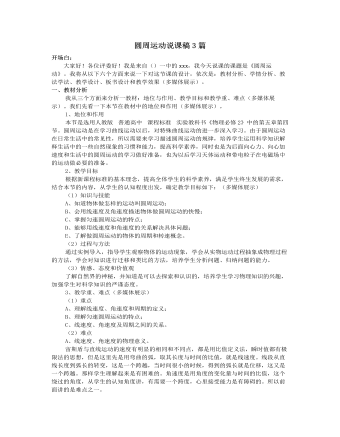
人教版新课标高中物理必修2圆周运动说课稿3篇
设计意图:通过设疑、讨论及学生的亲身体验与教师的引导,得到描述圆周运动快慢的两个物理量,也就成功的打破了学生在认识上的思维障碍,突破了物理概念教学的难点。在解决线速度和角速度的问题之后,我将引领学生学习匀速圆周运动的概念以及匀速圆周运动中线速度、角速度的特点。并引出匀速圆周运动中周期、转速的知识。为了加深学生对线速度、角速度与半径关系的认识,我设计了第三个学生体验活动:四名学生以我为圆心做圆周运动,四名学生始终并列,这时里圈同学走动不急不慢,而外圈同学则要小跑。通过学生的活动,不难发现在角速度相同的情况下,半径越大的线速度也越大。定性的得到了线速度、角速度与半径的关系。接下来让学生利用所学知识推导线速度、角速度与半径的关系。设计意图:这样就通过设疑、学生猜想、体验、推导的方式得到了结论,突破了本节课的难点即线速度、角速度与半径的关系。
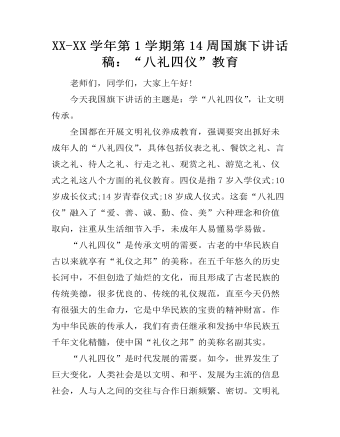
XX-XX学年第1学期第14周国旗下讲话稿:“八礼四仪”教育
老师们,同学们,大家上午好!今天我国旗下讲话的主题是:学“八礼四仪”,让文明传承。全国都在开展文明礼仪养成教育,强调要突出抓好未成年人的“八礼四仪”,具体包括仪表之礼、餐饮之礼、言谈之礼、待人之礼、行走之礼、观赏之礼、游览之礼、仪式之礼这八个方面的礼仪教育。四仪是指7岁入学仪式;10岁成长仪式;14岁青春仪式;18岁成人仪式。这套“八礼四仪”融入了“爱、善、诚、勤、俭、美”六种理念和价值取向,注重从生活细节入手,未成年人易懂易学易做。“八礼四仪”是传承文明的需要。古老的中华民族自古以来就享有“礼仪之邦”的美称。在五千年悠久的历史长河中,不但创造了灿烂的文化,而且形成了古老民族的传统美德,很多优良的、传统的礼仪规范,直至今天仍然有很强大的生命力,它是中华民族的宝贵的精神财富。
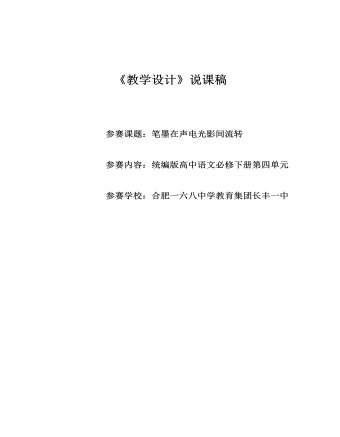
第四单元《教学设计》 说课稿 2021—2022学年统编版高中语文必修下册
(六)说教学策略1.专题性海量的媒介信息必须加以选择或者整合,以项目为依据,进行信息筛选,形成专题性阅读与交流;培养学生对文本信息“化零为整”的能力,提升跨媒介阅读与交流学习的充实感。2.情境化情境教学应指向学生的应用,建构富有符合时代气息的内容,与生活经验更加贴合,对学生的语言建构与运用有所提升,在情境中能够有效地进行交流。3.任务化以任务为导向的序列化学习,可以为学生构建学习路线图、学习框架等具体任务引导;或以跨媒介的认识与应用为任务的设置引导;甚至以阅读和交流作为序列化安排的实践引导。4.整合性跨媒介阅读与交流是结合线上线下的资源,形成新的“超媒介”,也能实现对信息进行“深加工”,多种媒介的信息整合只为一个核心教学内容服务。5.互文性语言文字是语文之生命,我们是立足于语言文字的探讨,音乐、图像、视频等文本与传统语言文字文本形成互文,触发学生对学习内容立体化和具体化的感悟,提升学生的审美能力。

新人教版高中英语必修3Unit 1 Festivals and Celebrations-Reading and Thinking教学设计
The topic of this part is “Discover the reasons for festivals and celebrations.The Listening & Speaking & Talking part aims at talking about the experiences and feelings or emotions about the festivals and celebrations. This section aims at detecting the reason why the people celebrate the festivals, the time, the places, the types and the way of celebrations. It also explains why some traditions in the old celebrations are disappearing, like the firecrackers in the big cities and some new things are appearing like the prosperity of business or commerce. 1. Students can talk about what festivals they know and the reasons and the way of celebrating them.2. Students should learn the reading skills such as the headline and get the topic sentences, the structures of articles.3. Students can understand the past, the present situation of some festival around the world and why there are some changes about them. 4. Students can have the international awareness about the festivals.1. Students should learn the reading skills such as the headline and get the topic sentences, the structures of articles.2. Students can understand the past, the present situation of some festival around the world and why there are some changes about them.Step 1 Lead in---Small talkWhat festival do you like best ? Why ?I like the Spring Festivals because I can set off the fireworks, receive the lucky money and enjoy the Gala with my families.Step 2 Before reading---Pair workWhy do people celebrate different festivals ?The Spring Festivals is to celebrate the end of winter and the coming of spring and new life.The Mid-autumn Day is to celebrate the harvest and admire the moon.

新人教版高中英语必修3Unit 1 Festivals and Celebrations-Reading for writing教学设计二
Step 3 Analyzing article structureActivity 31. Teachers raise questions to guide students to analyze the chapter structure of this diary and think about how to describe the festival experience. (1)What should be included in the opening/body/closing paragraph(s)?(2)How did the writer arrange his/her ideas?(3)What kind of interesting details did the writer describe?(4)How did the writer describe his/her feelings/emotions during the event?2. Students read and compare the three sentence patterns in activity 2. Try to rewrite the first paragraph of the diary with these three sentence patterns. After that, students exchange corrections with their partners. Such as:●This was my first time spending three days experiencing the Naadam Festival in China’s Inner Mongolia Autonomous Region and it was an enjoyable and exciting experience. ●I'll never forget my experience at the Naadam Festival because it was my first time to watch the exciting Mongolian games of horse racing, wrestling, and archery so closely. ●I'll always remember my first experience at the Naadam Festival in China’s Inner Mongolia Autonomous Region because it was so amazing to spend three days witnessing a grand Mongolian ceremony. Step 4 Accumulation of statementsActivity 41. Ask the students to read the diary again. Look for sentences that express feelings and emotions, especially those with the -ing form and the past participle. Such as:● …horse racing, wrestling, and archery, which are all so exciting to watch. ● some amazing performances● I was surprised to see…● I was a little worried about. . . ● feeling really tiredOther emotional statements:●I absolutely enjoyed the archery, too, but the horse races were my favourite part. ●I'm finally back home now, feeling really tired, but celebrating Naadam with my friend was totally worth it. ●He invited me back for the winter to stay in a traditional Mongolian tent and cat hot pot. I can’t wait!2. In addition to the use of the -ing form and the past participle, the teacher should guide the students in the appreciation of these statements, ask them to memorize them, and encourage them to use them reasonably in writing practice.

新人教版高中英语选修2Unit 1 Science and Scientists-Discovering useful structures教学设计
The grammatical structure of this unit is predicative clause. Like object clause and subject clause, predicative clause is one of Nominal Clauses. The leading words of predicative clauses are that, what, how, what, where, as if, because, etc.The design of teaching activities aims to guide students to perceive the structural features of predicative clauses and think about their ideographic functions. Beyond that, students should be guided to use this grammar in the context apporpriately and flexibly.1. Enable the Ss to master the usage of the predicative clauses in this unit.2. Enable the Ss to use the predicative patterns flexibly.3. Train the Ss to apply some skills by doing the relevant exercises.1.Guide students to perceive the structural features of predicative clauses and think about their ideographic functions.2.Strengthen students' ability of using predicative clauses in context, but also cultivate their ability of text analysis and logical reasoning competence.Step1: Underline all the examples in the reading passage, where noun clauses are used as the predicative. Then state their meaning and functions.1) One theory was that bad air caused the disease.2) Another theory was that cholera was caused by an infection from germs in food or water.3) The truth was that the water from the Broad Street had been infected by waste.Sum up the rules of grammar:1. 以上黑体部分在句中作表语。2. 句1、2、3中的that在从句中不作成分,只起连接作用。 Step2: Review the basic components of predicative clauses1.Definition

新人教版高中英语必修3Unit 1 Festivals and celebrations-Discovering Useful Structure教学设计
4.That was an experience that frightened everyone. →That was _____________________. 答案:1. taking 2. being discussed 3. in the reading room 4. a frightening experienceStep 6 The meaning and function of V-ing as the predicative动词-ing形式作表语,它通常位于系动词后面,用以说明主语“是什么”或“怎么样”一种表示主语的特质、特征和状态, 其作用相当于形容词; 另一种具体说明主语的内容, 即主语等同于表语, 两者可互换。The music they are playing sounds so exciting. 他们演奏的音乐听起来令人激动。The result is disappointing. 结果令人失望。Our job is playing all kinds of music. 我们的工作就是演奏各种音乐。Seeing is believing. 眼见为实。Step 7 Practice1. It is ________(amaze) that the boy is able to solve the problem so quickly.2. Buying a car is simply _______(waste) money. 3. Please stop making the noise—it’s getting ________(annoy). 4. complete the passage with the appropriate -ing form.La Tomatina is a festival that takes place in the Spanish town Bunol every August. I think many food festivals are __________ because people are just eating. however, this festival is _________ because people don't actually eat the tomatoes. Instead, they throw them at each other! the number of people ________ part in this tomato fight, can reach up to 20,000, and it is a very __________ fight that lasts for a whole hour. The _______ thing is how clean Bunol is after the tomatoes are washed away after the fight. this is because the juice form tomatoes is really good for making surfaces clean!答案:1. amazing 2. wasting 3. annoying4. boring interesting taking exciting amazing

新人教版高中英语必修3Unit 1 Festivals and Celebrations-Reading for Writing教学设计一
The topic of this part is “Write about your festival experience”.During the Listening and Speaking and Talking, students are just asked to say out their festival experiences such as the Spring Festival, Mid-autumn Day, but this part students will be asked to write down their own festival experiences. During the reading part, it introduces the Naadam Festival in Inner Mongolia Autonomous Region, which can give students a good example to imitate. Students not only learn the festival, but touch and feel the Inner Mongolian’s character, the spirit and cultural atmosphere, which can help students form the cultural awareness and learn to enjoy and value the diversity of Chinese culture.Concretely, the dairy tells the experience that the author spent the Naadam Festival in Inner Mongolia Autonomous Region with his/her friend. The structure is clear. In the opening paragraph, it introduces the topic of the Naadam Festival and the whole feeling. Then it introduces the items of the festival like the ceremony, wrestling and horse racing. Finally, it summarizes this experience. Because this part is a travel journal, we must guide students pay more attention to these details: 1. use the first person. 2. use the past tense to tell the past thing and use the present or future tense to describe the scenery. 3. use the timeline to tell the development. 4. be careful for the author’s psychology, emotion and feeling, etc.1. Read quickly to get main idea; read carefully to get the detailed information about Naadam Festival.2. Learn the structure of the reading article and language.3. Write an article about a festival experience4. Learn to use the psychology, emotions and feeling in the writing.1. Write an article about a festival experience.2. Use the structure of the reading article and language.

新人教版高中英语选修2Unit 1 Science and Scientists-Learning about Language教学设计
Step 7: complete the discourse according to the grammar rules.Cholera used to be one of the most 1.__________ (fear) diseases in the world. In the early 19th century, _2_________ an outbreak of cholera hit Europe, millions of people died. But neither its cause, 3__________ its cure was understood. A British doctor, John Snow, wanted to solve the problem and he knew that cholera would not be controlled _4_________ its cause was found. In general, there were two contradictory theories 5 __________ explained how cholera spread. The first suggested that bad air caused the disease. The second was that cholera was caused by an _6_________(infect) from germs in food or water. John Snow thought that the second theory was correct but he needed proof. So when another outbreak of cholera hit London in 1854, he began to investigate. Later, with all the evidence he _7_________ (gather), John Snow was able to announce that the pump water carried cholera germs. Therefore, he had the handle of the pump _8_________ (remove) so that it couldn't be used. Through his intervention,the disease was stopped in its tracks. What is more, John Snow found that some companies sold water from the River Thames that __9__________________ (pollute) by raw waste. The people who drank this water were much more likely _10_________ (get) cholera than those who drank pure or boiled water. Through John Snow's efforts, the _11_________ (threaten) of cholera around the world saw a substantial increase. Keys: 1.feared 2.when 3. nor 4.unless 5.that/which 6.infection 7.had gathered 8.removed 9.was polluted 10.to get 11. threat

新人教版高中英语选修2Unit 1 Science and Scientists-Reading and thinking教学设计
Step 5: After learning the text, discuss with your peers about the following questions:1.John Snow believed Idea 2 was right. How did he finally prove it?2. Do you think John Snow would have solved this problem without the map?3. Cholera is a 19th century disease. What disease do you think is similar to cholera today?SARS and Covid-19 because they are both deadly and fatally infectious, have an unknown cause and need serious public health care to solve them urgently.keys:1. John Snow finally proved his idea because he found an outbreak that was clearly related to cholera, collected information and was able to tie cases outside the area to the polluted water.2. No. The map helped John Snow organize his ideas. He was able to identify those households that had had many deaths and check their water-drinking habits. He identified those houses that had had no deaths and surveyed their drinking habits. The evidence clearly pointed to the polluted water being the cause.3. SARS and Covid-19 because they are both deadly and fatally infectious, have an unknown cause and need serious public health care to solve them urgently.Step 6: Consolidate what you have learned by filling in the blanks:John Snow was a well-known _1___ in London in the _2__ century. He wanted to find the _3_____ of cholera in order to help people ___4_____ it. In 1854 when a cholera __5__ London, he began to gather information. He ___6__ on a map ___7___ all the dead people had lived and he found that many people who had ___8____ (drink) the dirty water from the __9____ died. So he decided that the polluted water ___10____ cholera. He suggested that the ___11__ of all water supplies should be _12______ and new methods of dealing with ____13___ water be found. Finally, “King Cholera” was __14_____.Keys: 1. doctor 2. 19th 3.cause 4.infected with 5.hit 6.marked 7.where 8.drunk 9.pump 10.carried 11.source 12.examined 13.polluted 14.defeatedHomework: Retell the text after class and preview its language points

新人教版高中英语选修2Unit 1 Science and Scientists-Using langauge教学设计
This happens because the dish soap molecules have a strong negative charge, and the milk molecules have a strong positive charge. Like magnets, these molecules are attracted to each other, and so they appear to move around on the plate, taking the food coloring with them, making it look like the colors are quickly moving to escape from the soap.Listening text:? Judy: Oh, I'm so sorry that you were ill and couldn't come with us on our field trip. How are you feeling now? Better?? Bill: Much better, thanks. But how was it?? Judy: Wonderful! I especially liked an area of the museum called Light Games.it was really cool. They had a hall of mirrors where I could see myself reflected thousands of times!? Bill: A hall of mirrors can be a lot of fun. What else did they have?? Judy: Well, they had an experiment where we looked at a blue screen for a while, and then suddenly we could see tiny bright lights moving around on it. You'll never guess what those bright lights were!? Bill: Come on, tell me!? Judy: They were our own blood cells. For some reason, our eyes play tricks on us when we look at a blue screen, and we can see our own blood cells moving around like little lights! But there was another thing I liked better. I stood in front of a white light, and it cast different shadows of me in every color of the rainbow!? Bill: Oh, I wish I had been there. Tell me more!? Judy: Well, they had another area for sound. They had a giant piano keyboard that you could use your feet to play. But then, instead of playing the sounds of a piano, it played the voices of classical singers! Then they had a giant dish, and when you spoke into it, it reflected the sound back and made it louder. You could use it to speak in a whisper to someone 17 meters away.? Bill: It all sounds so cool. I wish I could have gone with you? Judy: I know, but we can go together this weekend. I'd love to go there again!? Bill: That sounds like a great idea!

新人教版高中英语必修3Unit 1 Festivals and Celebrations-Listening &Speaking&Talking教学设计
The theme of this section is “Talk about festival activities and festival experiences”.Festival and holiday is a relaxing and interesting topic for students. This part talks about the topic from the daily life of students’. In the part A ---Listening and Speaking, there are three conversations among different speakers from three countries(Japan, Rio and China), where the speakers are participating in or going to participate in the festivals and celebrations. So listening for the relationship among them is a fundamental task. Actually, with the globalization and more international communication, it is normal for Chinese or foreigners to witness different festivals and celebrations in or out of China. In the Conversation 1, a foreign reporter is interviewing a Japanese young girl who just had participated in the ceremony of the Coming-of-Age Day on the street and asking her feeling about the ceremony and the afterwards activities. Conversation 2, Chinese girl Li Mei is witnessing the Rio Carnival for the first time, and her friend Carla gives her some advice on the costumes which enables her to match with the carnival to have a good time. Conversation 3, a Chinese guide is showing a group of foreign visitors around the Lantern Festival and introducing the customs of the festival to them. The three conversations have a strong vitality and insert the festival and cultural elements from different countries. So perceiving the festivals and cultures from different countries is the second task. At the same time, the scripts also insert the targeted grammar --- v-ing as attributive and predicative, which students can perceive and experience in a real context and make a road for the further study. That is the third task. In the Part B--- Listening and Talking, the theme is “Talk about festival experience”, which is the common topic in our daily conversations. During the conversation, Song Lin, a Chinese student, asked Canadian friend Max about how to spend Christmas. In the conversation, Song Lin talked about experience and the feelings during the Chinese Spring Festival, during which there are not only some enjoyable things but some unpleasant things. After the listening, perhaps students find there are some similarities between Christmas and the Chinese Spring Festival as there are some differences in the origins and celebrations. For example, people always visit friends and relatives, decorate their houses, have a big dinner together, chat and give presents to each other.

初三学生国旗下讲话稿:国家富强 人民幸福
初三学生国旗下讲话稿:国家富强 人民幸福敬爱的老师,亲爱的同学们:大家好!今天我国旗下演讲的题目是“国家富强 人民幸福”。富强,顾名思义就是国家国力强盛,人民物质丰裕,精神丰富的象征。只有国家强盛,人民才能安居乐业。富强首先在于富民,人民富裕。民富国强,没有民富就没有国强,也就谈不上富强。国家富强也体现为国家拥有巨大的财富财力和强大的经济实力。国家富强是中华民族伟大复兴的中心任务。中国只有成为强国,才有实力和底气屹立于世界民族之林。对于一个国家来说,什么最重要?面对这个问题,可能答案很多:独立、民主等等。国富民强、国泰民安,从中国源远流长的历史、文化长河中,可以清楚的看出富强对一个国家的重要性。无论大国、小国,无论老牌国家还是新兴国家,追求国家富强,是一个永恒不变的主题。 一个国家的富强与否,往往是一个国家兴衰成败的标志。浩瀚历史,给了我们很多启示。一部近代中国史,可以完整的阐释富强对一个国家的意义:晚晴孱弱,一个个不平等的条约,伴随着黄金白银的流失、大片国土的丢失,国不像国、民不聊生成为近代中国屈辱历史的沉重内容。
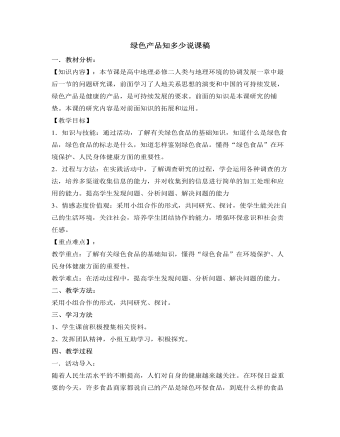
人教版高中地理必修2绿色产品知多少说课稿
各小组派代表汇报。4、教师提出问题组织学生讨论:⑴要想了解更多的绿色食品,了解绿色食品的销售情况,我们应该怎么做?⑵要想了解广大消费者对绿色食品的态度,食用绿色食品的意义,是否懂得辨认绿色食品,以及什么样的人群对此知识最缺乏等,我们应该怎么做?组织学生汇报交流。5、做个“绿色食品”广告设计师。为你喜欢的绿色食品设计广告语,每组推荐一个。6、让学生了解绿色食品认证程序。7、绿色食品打“假”队员在行动。8、向学生介绍生态绿色食品基地。三、活动总结:通过研究、探讨,了解学生对绿色食品的态度。提问:民以食为天,吃,是一个大问题,如果你的爸爸妈妈让你到超市买牛奶、方便面等,你会选择什么样的食品?为什么?希望通过今天的学习,同学们能够做到绿色消费,也希望你们向自己的家人、向周围的了解学生对“无公害食品”、“有机食品”与“绿色食品”的认识。
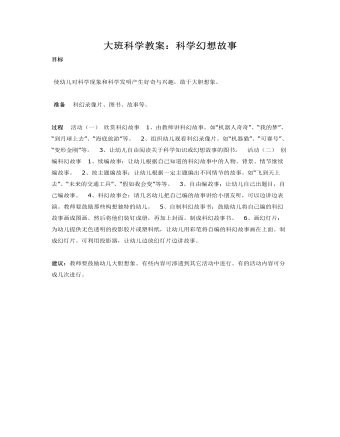
大班科学教案:科学幻想故事
过程 活动(一)欣赏科幻故事 1、由教师讲科幻故事。如“机器人奇奇”、“我的梦”、“到月球上去”、“海底旅游”等。 2、组织幼儿观看科幻录像片。如“机器猫”、“可赛号”、“变形金刚”等。 3、让幼儿自由阅读关于科学知识或幻想故事的图书。 活动(二)创编科幻故事 1、续编故事:让幼儿根据自己知道的科幻故事中的人物、背景、情节继续编故事。
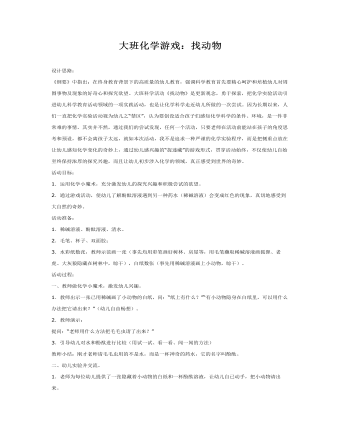
大班科学教案:化学游戏:找动物
活动目标: 1.运用化学小魔术,充分激发幼儿的探究兴趣和积极尝试的欲望。 2.通过游戏活动,使幼儿了解酚酞溶液遇到另一种药水(稀碱溶液)会变成红色的现象,真切地感受到大自然的奇妙。 活动准备: 1.稀碱溶液、酚酞溶液、清水。 2.毛笔、杯子、双面胶; 3.水彩纸数张,教师示范画一张(事先均用彩笔画好树林、房屋等,用毛笔蘸取稀碱溶液画狐狸、老虎、大灰狼隐藏在树林中,晾干),白纸数张(事先用稀碱溶液画上小动物,晾干)。 活动过程: 一、教师做化学小魔术,激发幼儿兴趣。 1.教师出示一张已用稀碱画了小动物的白纸,问:“纸上有什么?”“有小动物隐身在白纸里,可以用什么办法把它请出来?”(幼儿自由畅想)。 2.教师演示: 提问:“老师用什么方法把毛毛虫请了出来?” 3.引导幼儿对水和酚酞进行比较(用试一试、看一看、闻一闻的方法) 教师小结:刚才老师请毛毛虫用的不是水,而是一杯神奇的药水,它的名字叫酚酞。
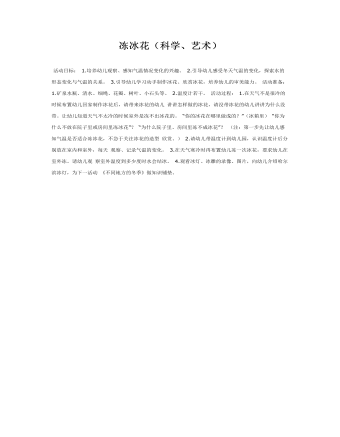
大班科学教案:冻冰花(科学、艺术)
2.引导幼儿感受冬天气温的变化,探索水的形态变化与气温的关系。 3.引导幼儿学习动手制作冰花、欣赏冰花,培养幼儿的审美能力。活动准备: 1.矿泉水瓶、清水、细绳、花瓣、树叶、小石头等。 2.温度计若干。活动过程: 1.在天气不是很冷的时候布置幼儿回家制作冰花后,请带来冰花的幼儿讲讲怎样做的冰花,请没带冰花的幼儿讲讲为什么没带。让幼儿知道天气不太冷的时候室外是冻不出冰花的。 “你的冰花在哪里做成的?”(冰箱里) “你为什么不放在院子里或房间里冻冰花”? “为什么院子里、房间里冻不成冰花”?

